Sights
- Address: Palazzo Venier dei Leoni 701
- Website: www.guggenheim-venice.it
- Price: adult/over 65yr/student with ID to 26yr/under 10yr €10/8/5/free
- Hours: 10am-6pm Wed-Mon
Peggy Guggenheim Collection
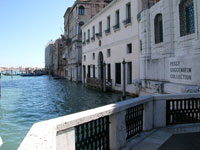
After tragically losing her father on the Titanic, heiress Peggy Guggenheim befriended Dadaists, dodged Nazis, and amassed avant-garde works by 200 modern artists at her palatial home on the Grand Canal. Peggy’s Palazzo Venier dei Leoni became a modernist shrine, chronicling surrealism, Italian futurism, and abstract expressionism, with a subtext of Peggy’s romantic pursuits – the collection includes key works by Peggy’s ex-husband Max Ernst and Jackson Pollock, among Peggy’s many rumored lovers. Peggy collected according to her own convictions rather than for prestige or style, so her collection includes inspired folk art and lesser-known local artists alongside artists recognized internationally by just one name, including Kandinsky, Picasso, Rothko, Klee, Brancusi, Mondrian and Dali. Peggy was more than a mere tastemaker; her spirited advocacy sparked renewed interest in Italian art, which had largely gone out of favor with the rise of Mussolini and the partisan politics of WWII. For this Jewish American champion of Italian art who’d witnessed the dangers of censorship and party-line dictates, serious artwork deserved to be seen and judged on its merits. Her support led to reappraisals of Umberto Boccioni, Giorgio Morandi, Giacomo Balla and Giorgio de Chirico, and aided Venice’s own Emilio Vedova. Wander around works by Moore, Giacometti and Arp in the sculpture garden, where the city of Venice granted Peggy honorary dispensation to be buried alongside her pet dogs in 1979. Espresso is served among art installations at the garden cafe, and around the corner from the museum on Fondamenta Venier dei Leoni is the museum bookstore, selling art books in several languages and replicas of Peggy’s signature glasses – winged, like the lion of San Marco.
- Address: Piazza San Marco
- Website: www.basilicasanmarco.it
- Hours: 9:45-17:00 Mon-Sat,
14:00-16:00 Sun & holidays
Basilica di San Marco
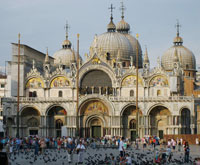
Luminous angels trumpet the way into San Marco in glittering mosaics above vast portals. Inside, the soaring stone structure still sets standards for razzle-dazzle, from the intricate geometry of 12th-century polychrome marble floors to 11th- to 15th-century mosaic domes glittering with millions of gilt-glass tesserae (tiles). This show-stopper took a brains trust of Mediterranean artisans almost 800 years and grand larceny to complete. Legend has it that Venetian merchants smuggled the corpse of St Mark out of Egypt in 828; the arrival of St Mark’s body in Venice is depicted in mosaics dating from 1270 on the left of the facade. Riots and fires thrice destroyed exterior mosaics and weakened the basilica’s underlying structure, so Jacopo Sansovino and other church architects grafted on supports and every precious marble available by purchase or pillage. Occasionally higher purpose got clouded over by construction dust: St Mark’s bones were misplaced twice. Church authorities in Rome took a dim view of Venice’s tendency to glorify itself and God in the same breath, but Venice finished San Marco in its own East-meets-West style: Eastern onion-bulb domes, a Greek cross layout, Gothic arches, and Egyptian porphyry walls. The roped-off circuit of the church is free and takes about 15 minutes to walk. In niches flanking the main door as you enter the narthex (vestibule) are glittering Apostles with the Madonna, who looks stunning for her age: at more than 950 years old, these are the oldest mosaics in the basilica. Another medieval masterpiece is the Dome of Genesis, which depicts the separation of sky and water and angels with surprisingly abstract, conceptual motifs that anticipate modern art by 650 years. The golden central dome is the 13th-century Cupola of the Ascension, where you’ll note angels swirling overhead and dreamy-eyed St Mark on the pendentive (dome support). Alabaster chalices, icons and other Crusades booty in the Tesoro (Treasury; admission €3; 9.45am-5pm Mon-Sat Apr-Oct, 9.45am-4pm Mon-Sat Nov-Mar, 2-4pm Sun & holidays) can’t quite compare with the bejewelled Pala d’Oro (admission €2; 9.45am-5pm Mon-Sat Apr-Oct) altarpiece. Tucked behind the high altar that towers above St Mark’s sarcophagus, this hidden treasure contains almost 2000 emeralds, amethysts, sapphires, rubies, pearls and other gemstones. More impressive still are the minuscule saints’ portraits and lively biblical scenes in vibrant cloisonné, begun in Constantinople in 976 and elaborated by Venetian goldsmiths in 1209. San Marco was officially the doge’s (duke’s) chapel until 1807, and the doge’s far-reaching influence is highlighted by gilt bronze horses upstairs in the Galleria (Museo di San Marco; admission €4; same as basilica). Through the Galleria you can access the Loggia dei Cavalli, where reproductions of the bronze horses gallop off the balcony over Piazza San Marco. Note that you’ll need to be dressed modestly (i.e. knees and shoulders covered) to enter the basilica, and large bags must be left around the corner off Piazzetta San Marco dei Leoni at Ateneo di San Basso, where you’ll find free one-hour baggage storage (9.30am-5.30pm daily). (back to top)
St Mark's Square
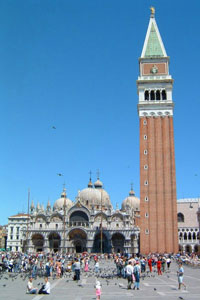 Napoleon dubbed it the 'finest drawing room in Europe', and visitors and pigeons alike have been flocking here for centuries to strut and crow. There is a constant carnival atmosphere thanks to the cacophony of duelling cafe orchestras, cooing pigeons, and constant traffic of waiters serving alfresco diners.
Napoleon dubbed it the 'finest drawing room in Europe', and visitors and pigeons alike have been flocking here for centuries to strut and crow. There is a constant carnival atmosphere thanks to the cacophony of duelling cafe orchestras, cooing pigeons, and constant traffic of waiters serving alfresco diners.
Now that most visitors arrive in Venice via the railway station, the magical symbolism of the waterside Piazzetta San Marco has to a great extent been lost.
The piazzetta's two columns bear emblems of the city's patron saints: the winged lion of St Mark and the figure of St Theodore. From the Campanile (bell tower), you can enjoy breathtaking views. St Mark's Square is also one of the lowest parts of the city, and thus the first to be covered in water when the acqua alta (high tide) arrives - a magical sight on a moonlit night.
- Address: Bell Tower
- Website: www.basilicasanmarco.it
- Price: admission €8
- Hours: 9am-9pm daily Jul-Sep,
9am-7pm Apr-Jun & Oct,
9.30am-3.45pm Nov-Mar
Campanile
The 30m-tall bell tower has been rebuilt twice since its initial construction in 888, and was long used as the city’s main lighthouse. Critics have called the tower squat and ungainly, but when it suddenly collapsed in 1902, Venetians rebuilt the tower exactly as it was, brick by brick. Entry to the tower leads through the ground-floor Loggetta, a light Renaissance touch by Sansovino and, when the tower is open to the public, a lift whisks visitors to the top for spectacular panoramas over the city. But you may have to admire it from below: due to ongoing stabilisation efforts, the bell tower may be closed on your visit. (back to top)
- Address: Campo della Salute 1b
- Website www.marcianum.it
- Price: sacristy admission €1.50
- Hours: 9am-noon & 3-5.30pm daily
Chiesa di Santa Maria della Salute
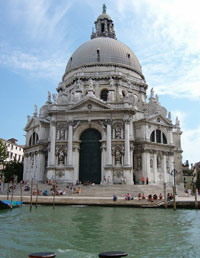
Shows of appreciation don’t get much more monumental than Venice’s magnificent baroque church to the Sainted Mary of Health, dedicated by Venice’s Senate to the Madonna for sparing the city further devastation after a brutal 1630–31 bout of plague killed a third of the city’s population in 18 months. At least 100,000 pylons had to be driven deep into the barene (mud banks) to shore up the tip of Dorsoduro and support the weight of this baroque engineering marvel. Baldassare Longhena’s unusual domed octagon is an inspired design that architectural scholars have compared to Graeco-Roman temples and Jewish cabbala diagrams, and the site of Venetians’ annual pilgrimage to pray for health. Inside, you’ll spot Tintoretto’s surprisingly upbeat The Wedding Feast of Cana en route to the sacristy, which features no fewer than 12 Titians, including a vivid self-portrait in the guise of St Matthew, and his earliest known work, the precocious vermilion Saint Mark on the Throne from 1510. (back to top)
- Address:
Campo SS Giovanni e Paolo
Statue of Bartolomeo Colleoni
You’ll know you’ve crossed from Cannaregio into Castello when you spot Bartolomeo Colleoni galloping out to meet you. The bronze equestrian statue is one of only two such public monuments in Venice, commemorating one of Venice’s more loyal mercenary mainland commanders. From 1448, Colleoni commanded armies for the Republic – though in true mercenary form he switched sides a couple of times when he felt he’d been stiffed on pay or promotions. On his death in 1474, he bequeathed 216,000 gold and silver ducats and even more in property to Venice, on one condition: that the city erect a commemorative statue to him in Piazza San Marco. Since not even a doge had ever won such pride of place in Venice, the Senate found a loophole by reading a clause into the contract: the grand statue would be placed in the Piazza in front of the Scuola Grande di San Marco instead. At least Colleoni can rest easy that the Republic didn’t scrimp on the statue, sculpted with imposing grandeur by Verrocchio (1435–88). (back to top)
- Address: Piazzetta di San Marco 52
- Price: admission incl Museo Correr plus 1 civic museum of choice with/without discount pass €8/13
- Hours: 9am-7pm Apr-Oct, 9am-5pm Nov-Mar
Doge’s Palace
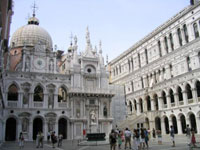
The Palazzo Ducale, or Doge’s Palace, was the seat of the government of Venice for centuries. As well as being the home of the Doge (the elected ruler of Venice) it was the venue for its law courts, its civil administration and bureaucracy and — until its relocation across the Ponte dei Sospiri (Bridge of Sighs) — the city jail.
The system of doges elected for life was as singular as everything else about this very singular city, and lasted for 1000 years, from the election of Paolo Lucio Anafesto in 697AD to the deposing of Ludovico Nanin in 1789.
The doge sat on numerous of the committees and thus played a huge role in steering policy; the principle of rule for life was an attempt to establish stability, a mature check on the whims of temporarily elected officials … not unlike Britain’s House of Lords. But the Venetians were wary of the corruptions of lifetime rule and established a similarly complex system of checks on the doge. All his mail was read first by the censor; all foreign dignitaries were received in committee rather than by the doge alone.
The Palazzo Ducale is a superb example of Venetian Gothic architecture and even later vandalism didn’t spoil it.
The decoration is enormously elaborate and impressive. The 36 capitals on the lower colonnade of the building have carvings of beasts, flowers and representations of the months of the year. Didactic moral sculptures represent scenes such as the Judgement of Solomon, the Drunkenness of Noah and Adam and Eve with the Archangel Gabriel, and so on.
You will enter the palazzo through a door next to the Lagoon, and enter an enormous courtyard, and the Arco Foscari. Here we see the mix of styles that make up the palace, as successive doges tried to make the palace ever more magnificent. Antonio Rizzo built the eastern façade in 1485, an exercise in Renaissance classicism, decorated by Pietro, Antonio and Tullio Lombardo. The south and west sides meanwhile, are Gothic in flavor. Sansovino built an enormous staircase, the Scala dei Giganti, in the mid-16th century. Spavento, Scarpagnino and Bartolomeo Monopola completed the courtyard in around 1600. (back to top)
- Address: Santa Croce 1730 Salizada del Fontego dei Turchi
- Website: www.museiciviciveneziani.it
- Hours: 9am-12.30pm Tue-Fri, 10am-3.30pm Sat & Sun
Fondaco dei Turchi
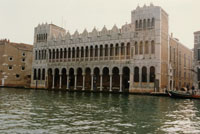
The dukes of Ferrara had the run of this 12th-century mansion until they were elbowed aside in 1621 to make room for Venice’s most important trading partner: Turkey. For centuries the building served as a way station and warehouse for Turkish merchants, who were a constant in Venice throughout the on-again, off-again relationship between maritime powers, celebrated with favored-nation trading status and inter-Adriatic weddings, and marred by occasional acts of piracy, invasion and looting. The Fondaco dei Turchi remained rented out to the Turks until 1858, after which the place underwent a disastrous modernisation that left few reminders of its medieval origins. Original features in the facade were sacrificed to the architectural fancies of the time, including odd crenellations that made the gracious Gothic buidling look more like a prison. Today it houses a scientific library and the rather half-hearted Museo Civico di Storia Naturale (Natural History Museum), which consists of two main displays. The first is on the ground floor: a rather small, sad fish tank containing Venetian coastal specimens bubbling for attention. On the 2nd floor is a more exciting display of dinosaurs, including an ouransaurus from the Sahara, a 12m-long prehistoric crocodile skeleton, and a 120-million-year-old psittacosaurus mongoliensis, a 0.5m-long skeleton of a baby dinosaur found in the Gobi Desert. (back to top)
- Address: Santa Croce 2076 Fondamenta di Ca’ Pesaro
- Website: www.museiciviciveneziani.it
- Price: adult/senior, student & child €5.50/3
- Hours: 10am-6pm Tue-Sun Apr-Oct, 10am-5pm Tue-Sun Nov-Mar
Ca’ Pesaro
Eclectic collections ranging from a Klimt masterpiece to samurai swords span three floors of this Baldassare Longhena– designed 1710 palazzo. When the palace was donated to the city as a showcase for new ideas in 1902, the Galleria d’Arte Moderna began with the boosterish early days of the Biennale, showcasing Venetian landscapes, Venetian painters (notably Giacomo Favretto), and Venetian socialites embodying mythological virtues. But savvy Biennale collectors soon diversified, snapping up pivotal works such as Gustav Klimt’s 1909 Judith II (Salome) and Marc Chagall’s Rabbi of Vitebsk (1914–22). The De Lisi Bequest in 1961 added Kandinskys and Morandis to the modernist mix of De Chiricos, Mirós and Moores. Upstairs, step back in time through the phalanx of samurai warriors at the quirky Museo d’Arte Orientale, evidence of Prince Enricodi Borbone’s 1887–89 souvenir shopping spree across Asia preserved for posterity in vintage curio cabinets. The prince reached Japan when Edo art was discounted in favour of modern Meiji, and Edo-era swords, netsukes, and a lacquerware palanquin are his standout acquisitions in this collection of 30,000 objets d’art. The collection has been left much as it was organised in 1928, setting a retro scene perfect for an Indiana Jones sequel. (back to top)
- Address: Calle di Ca’ d’Oro 3932 Golden House
- Website: www.cadoro.org
- Price: adult/EU student under 26yr/EU citizen under 18yr or over 65yr €5/2.50/free
- Hours: 8:15am-2pm Mon, 8:15am-7:15pm Tue-Sun
Ca’ d’Oro

Along the Grand Canal, you can’t miss the stunning 15th-century Ca’ d’Oro, its lacy Gothic facade resplendent even without the original gold-leaf details that gave the palace its name (‘Golden House’). Ca’ d’Oro was donated to Venice with an impressive art collection by Baron Franchetti (of Palazzo Franchetti fame). Today it houses these works in the 2nd-floor Galleria Franchetti, plus a jackpot of artwork downstairs plundered from Veneto churches during Napoleon’s Italy conquest. Napoleon had excellent taste in souvenirs, as the 1st floor reveals: bronzes, tapestries, paintings and sculpture ripped (sometimes literally) from Veneto churches were warehoused at Milan’s Brera Museum as Napoleonic war trophies, until they were reclaimed by Venice for display here. Collection highlights on the 2nd floor include Andrea Mantegna’s teeth-baring, arrow-riddled Saint Sebastian altarpiece, Pietro Lombardo’s tender Madonna and Child in glistening Carrara marble, and pieces of Titian frescoes along with a faded but still sensuous nude fresco fragment by Giorgione saved from the outside of the Fondaco dei Tedeschi. A big incentive for visiting are the photo ops along the loggia balconies over the Grand Canal, with arty angles through lacy stonework. (back to top)
- Address: San Polo 2794 Calle dei Nomboli
- Website: www.museiciviciveneziani.it
- Price: adult/senior, student & child €2.50/1.50
- Hours: 10am-5pm Mon-Sat Apr-Oct, 10am-4pm Mon-Sat Nov-Mar
Casa di Goldoni
 Comedians, musicians and writers will feel inspiration bubbling up like a belly laugh from the stone floors at the birthplace of Carlo Goldoni (1707–93), Venice’s greatest playwright and a maestro of delicious social satire and opera buffa (comic opera). As the 1st-floor display explains (in Italian), Goldoni was a master of second and third acts: he was a doctor’s apprentice before switching to law, a backup career that proved handy when some comedies didn’t sell. But Goldoni had the last laugh, with salon sitcoms that made socialites laugh at themselves. The main draws in the museum are the 18th-century marionettes and puppet theatre, but don’t miss the chamber-music concerts held here. Otherwise, the entrance is the most striking part of the 15th-century Gothic house, with its quiet courtyard, private well and stairway in Istrian stone. (back to top)
Comedians, musicians and writers will feel inspiration bubbling up like a belly laugh from the stone floors at the birthplace of Carlo Goldoni (1707–93), Venice’s greatest playwright and a maestro of delicious social satire and opera buffa (comic opera). As the 1st-floor display explains (in Italian), Goldoni was a master of second and third acts: he was a doctor’s apprentice before switching to law, a backup career that proved handy when some comedies didn’t sell. But Goldoni had the last laugh, with salon sitcoms that made socialites laugh at themselves. The main draws in the museum are the 18th-century marionettes and puppet theatre, but don’t miss the chamber-music concerts held here. Otherwise, the entrance is the most striking part of the 15th-century Gothic house, with its quiet courtyard, private well and stairway in Istrian stone. (back to top)
- Address: San Polo 3052 Campo San Rocco
- Website: www.scuolagrandisanrocco.it
- Price: adult/18-26yr/under 18yr €7/5/free
- Hours: 9am-5.30pm Easter-Oct, 10am-5pm Nov-Easter
Scuola Grande di San Rocco
You’ll swear the paint is still fresh on the 50 action-packed Tintorettos painted between 1575 and 1587 for the Scuola Grande di San Rocco. Everyone wanted the commission to paint this building dedicated to the patron saint of the plague-stricken, so Tintoretto cheated a little: instead of producing sketches like his rival Veronese, Tintoretto painted a magnificent tondo (ceiling panel) and dedicated it to the saint, knowing such a gift couldn’t be refused or matched by other artists. Take the Scarpagnino staircase to the Sala Grande Superiore, in which Tintoretto covered the ceilings with Old Testament scenes that read like a modern graphic novel. Grab a handglass (mirror) to avoid the otherwise inevitable neck strain as you ogle Tintoretto’s riveting ceilings – you can almost hear the swoop overhead as an angel dives down to feed an ailing Elijah. Unlike Venetian colourists, Tintoretto concentrated on dynamic lines for his New Testament wall scenes, foreshadowing abstract expressionism by centuries. Against the shadowy backdrop of the Black Death, Tintoretto highlights his subjects in lightning streaks of hope. Downstairs, the assembly hall contains a handful of works by other artists including Titian, Giorgione and Tiepolo, and illuminates the story of the Virgin Mary. The story begins on the left wall with the Annunciation and ends with the Ascension opposite – dark and cataclysmic, compared with Titian’s glowing version at I Frari. Scarpagnino’s buoyant, proto-baroque Renaissance facade puts a brave face on the confraternity dedicated to San Rocco, who at age 20 in 1315 began wandering southern France and northern Italy helping plague victims until his death at 32. His body was transferred to Venice as a plague-prevention talisman in 1485, providing backup to the new system of vigorous quarantine pioneered by Venice with inspections and waiting periods for incoming ships at Lazaretto. Between the two, Venice managed to escape the worst of the bouts of plague that wracked Europe and devastated Italy for centuries. (back to top)
- Address: Campo San Vidal & Campo della Carità San Marco
Ponte dell'Accademia
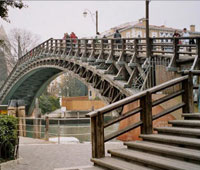
The wooden Ponte dell’Accademia, with a high arch like a cat’s back, was built in 1933 as a temporary replacement for an 1854 iron bridge, but it remains a beloved landmark. Engineer Eugenio Miozzi moved onto bigger Fascist monuments such as the Lido casino and the Ponte della Libertà bridge to the mainland, but none has stood the test of time quite like this elegant little footbridge. Renovations scheduled to begin in 2010/11 are long overdue, but the city is quick to reassure the bridge’s ardent admirers that changes will be overwhelmingly structural.
One of the most common images from Venice is the view of the Chiesa di Santa Maria della Salute from this spot. The bridge links the sestiere of San Marco with Dorsoduro. In front of you across the bridge are the Gallerie dell'Accademia. (back to top)
